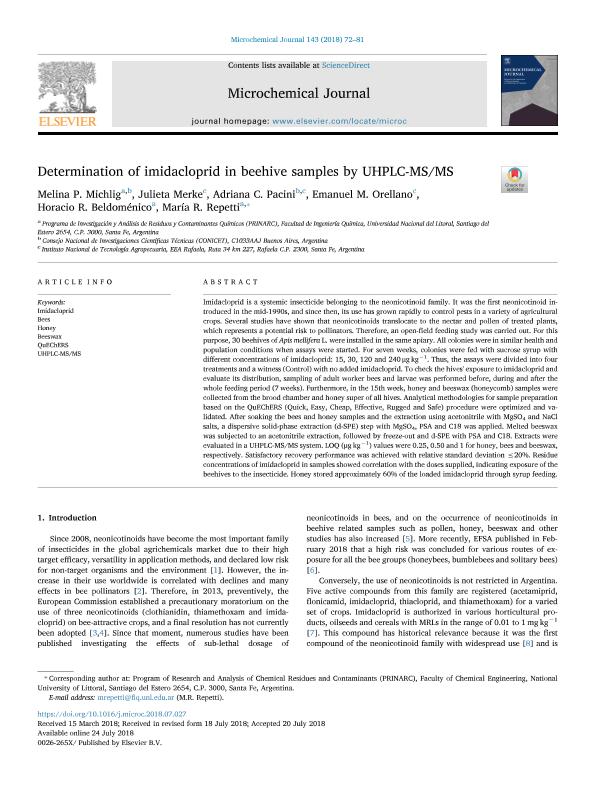Mostrar el registro sencillo del ítem
dc.contributor.author
Michlig, Melina Paola

dc.contributor.author
Merke, Julieta

dc.contributor.author
Pacini, Adriana Cecilia

dc.contributor.author
Orellano, Ramiro Emanuel

dc.contributor.author
Beldomenico, Horacio Ramon

dc.contributor.author
Repetti, María Rosa

dc.date.available
2019-08-29T22:03:41Z
dc.date.issued
2018-12
dc.identifier.citation
Michlig, Melina Paola; Merke, Julieta; Pacini, Adriana Cecilia; Orellano, Ramiro Emanuel; Beldomenico, Horacio Ramon; et al.; Determination of imidacloprid in beehive samples by UHPLC-MS/MS; Elsevier Science; Microchemical Journal; 143; 12-2018; 72-81
dc.identifier.issn
0026-265X
dc.identifier.uri
http://hdl.handle.net/11336/82571
dc.description.abstract
Imidacloprid is a systemic insecticide belonging to the neonicotinoid family. It was the first neonicotinoid introduced in the mid-1990s, and since then, its use has grown rapidly to control pests in a variety of agricultural crops. Several studies have shown that neonicotinoids translocate to the nectar and pollen of treated plants, which represents a potential risk to pollinators. Therefore, an open-field feeding study was carried out. For this purpose, 30 beehives of Apis mellifera L. were installed in the same apiary. All colonies were in similar health and population conditions when assays were started. For seven weeks, colonies were fed with sucrose syrup with different concentrations of imidacloprid: 15, 30, 120 and 240 μg kg −1 . Thus, the assays were divided into four treatments and a witness (Control) with no added imidacloprid. To check the hives’ exposure to imidacloprid and evaluate its distribution, sampling of adult worker bees and larvae was performed before, during and after the whole feeding period (7 weeks). Furthermore, in the 15th week, honey and beeswax (honeycomb) samples were collected from the brood chamber and honey super of all hives. Analytical methodologies for sample preparation based on the QuEChERS (Quick, Easy, Cheap, Effective, Rugged and Safe) procedure were optimized and validated. After soaking the bees and honey samples and the extraction using acetonitrile with MgSO 4 and NaCl salts, a dispersive solid-phase extraction (d-SPE) step with MgSO 4 , PSA and C18 was applied. Melted beeswax was subjected to an acetonitrile extraction, followed by freeze-out and d-SPE with PSA and C18. Extracts were evaluated in a UHPLC-MS/MS system. LOQ (μg kg −1 ) values were 0.25, 0.50 and 1 for honey, bees and beeswax, respectively. Satisfactory recovery performance was achieved with relative standard deviation ≤20%. Residue concentrations of imidacloprid in samples showed correlation with the doses supplied, indicating exposure of the beehives to the insecticide. Honey stored approximately 60% of the loaded imidacloprid through syrup feeding.
dc.format
application/pdf
dc.language.iso
eng
dc.publisher
Elsevier Science

dc.rights
info:eu-repo/semantics/openAccess
dc.rights.uri
https://creativecommons.org/licenses/by-nc-nd/2.5/ar/
dc.subject
Bees
dc.subject
Beeswax
dc.subject
Honey
dc.subject
Imidacloprid
dc.subject
Quechers
dc.subject
Uhplc-Ms/Ms
dc.subject.classification
Química Analítica

dc.subject.classification
Ciencias Químicas

dc.subject.classification
CIENCIAS NATURALES Y EXACTAS

dc.title
Determination of imidacloprid in beehive samples by UHPLC-MS/MS
dc.type
info:eu-repo/semantics/article
dc.type
info:ar-repo/semantics/artículo
dc.type
info:eu-repo/semantics/publishedVersion
dc.date.updated
2019-08-08T18:09:46Z
dc.journal.volume
143
dc.journal.pagination
72-81
dc.journal.pais
Países Bajos

dc.journal.ciudad
Amsterdam
dc.description.fil
Fil: Michlig, Melina Paola. Universidad Nacional del Litoral; Argentina. Consejo Nacional de Investigaciones Científicas y Técnicas. Centro Científico Tecnológico Conicet - Santa Fe; Argentina
dc.description.fil
Fil: Merke, Julieta. Instituto Nacional de Tecnología Agropecuaria. Centro Regional Santa Fe. Estación Experimental Agropecuaria Rafaela; Argentina. Consejo Nacional de Investigaciones Científicas y Técnicas. Centro Científico Tecnológico Conicet - Santa Fe; Argentina
dc.description.fil
Fil: Pacini, Adriana Cecilia. Consejo Nacional de Investigaciones Científicas y Técnicas. Centro Científico Tecnológico Conicet - Santa Fe; Argentina. Instituto Nacional de Tecnología Agropecuaria. Centro Regional Buenos Aires; Argentina
dc.description.fil
Fil: Orellano, Ramiro Emanuel. Instituto Nacional de Tecnología Agropecuaria. Centro Regional Buenos Aires; Argentina
dc.description.fil
Fil: Beldomenico, Horacio Ramon. Universidad Nacional del Litoral. Facultad de Ingeniería Química; Argentina. Consejo Nacional de Investigaciones Científicas y Técnicas; Argentina
dc.description.fil
Fil: Repetti, María Rosa. Universidad Nacional del Litoral. Facultad de Ingeniería Química; Argentina. Consejo Nacional de Investigaciones Científicas y Técnicas; Argentina
dc.journal.title
Microchemical Journal

dc.relation.alternativeid
info:eu-repo/semantics/altIdentifier/doi/https://doi.org/10.1016/j.microc.2018.07.027
dc.relation.alternativeid
info:eu-repo/semantics/altIdentifier/url/https://www.sciencedirect.com/science/article/pii/S0026265X18303278
Archivos asociados
